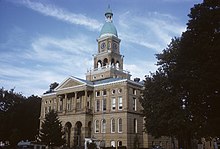Hillsdale County, Michigan
| Hillsdale County, Michigan | |
|---|---|

|
|
 Location in the U.S. state of Michigan |
|
 Michigan's location in the U.S. |
|
| Founded | 1835 |
| Seat | Hillsdale |
| Largest city | Hillsdale |
| Area | |
| • Total | 607 sq mi (1,572 km2) |
| • Land | 598 sq mi (1,549 km2) |
| • Water | 8.9 sq mi (23 km2), 1.5% |
| Population | |
| • (2010) | 46,688 |
| • Density | 78/sq mi (30/km²) |
| Congressional district | 7th |
| Time zone | Eastern: UTC-5/-4 |
| Website | www |
Hillsdale County is a county located in the U.S. state of Michigan. As of the 2010 census, the population was 46,688. The county seat is Hillsdale.
Hillsdale County comprises the Hillsdale, MI Micropolitan Statistical Area.
The Hillsdale County Courthouse was built by Claire Allen, a prominent southern Michigan architect.
The county is named for its rolling terrain. It was set off in 1829, and organized six years later.See List of Michigan county name etymologies. Hillsdale County was a New England settlement. The original founders of Hillsdale consisted entirely of settlers from New England. These people were "Yankee's", that is to say they were descended from the English Puritans who settled New England in the 1600s. They were part of a wave of New England farmers who headed west into what was then the wilds of the Northwest Territory during the early 1800s. Most of them arrived as a result of the completion of the Erie Canal as well as the close of the Black Hawk War. When they arrived in what is now Hillsdale County there was nothing but a virgin forest and wild prairie, the New Englanders laid out farms, constructed roads, erected government buildings and established post routes. They brought with them many of their Yankee New England values, such as a passion for education, establishing many schools as well as staunch support for abolitionism. They were mostly members of the Congregationalist Church though some were Episcopalian, however as a result of the Second Great Awakening many became Baptists and many also converted to Methodism before arriving in Michigan. The people of Hillsdale County, like many others in Michigan, maintained a cultural affinity with early New England.
...
Wikipedia
